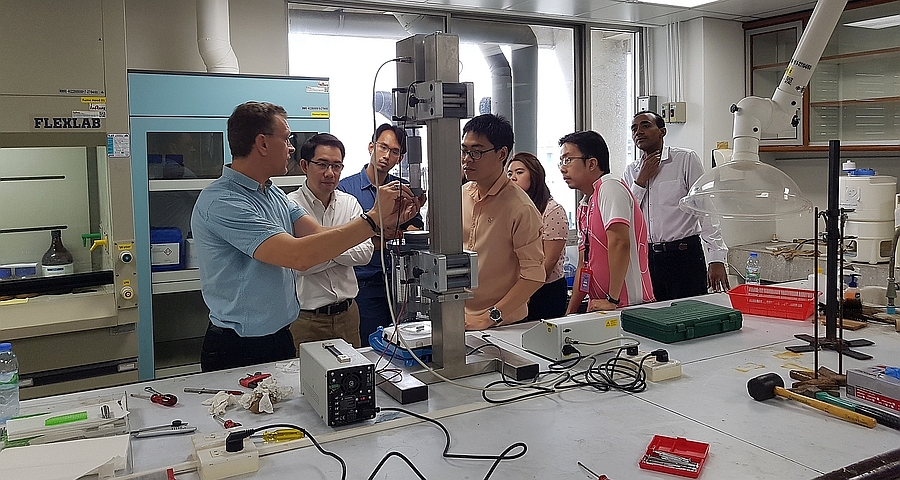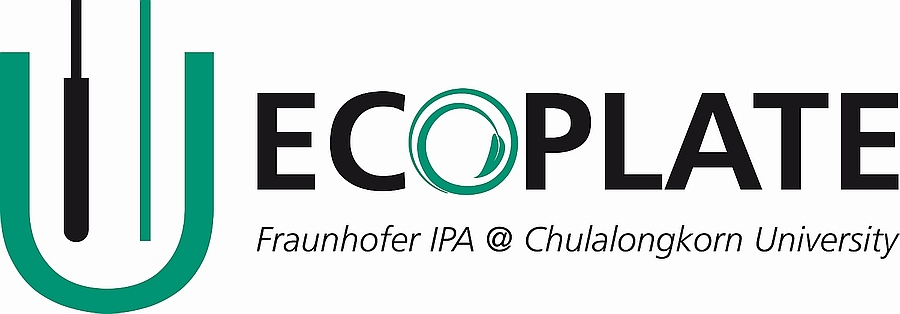Electrochemical coating technologies are known and widely used as electroplating technologies. They are key technologies for all industries and therefore of high importance for industrialized countries and for emerging economies. When used properly, electroplating technology is safe for humans and the environment. Nevertheless, further increases in energy and material efficiency can be achieved through innovations in processes and equipment.

Aufbau eines IPA Elektrolytprüfstandes im ECOPLATE Labor am MMRI © Martin Metzner
The Electroplating Department of the Fraunhofer Institute for Manufacturing Engineering and Automation and the Metallurgy and Materials Science Research Institute of Chulalongkorn University in Bangkok are pioneers in electroplating research and are driving energy efficiency within electroplating with the research station.
Technical background
Electroplating technology is very widespread. The applications of electroplated surfaces cover all relevant industries. For automotive applications, brackets are galvanised, bearings hard-chrome plated or non-ferrous metal plated, piston rings hard-chrome plated, steering housings anodised and trims and controls copper plated, nickel plated and then chrome plated. In mechanical engineering, bearings, shafts and rollers, tools and brackets are coated with functional electroplated layers such as nickel, chrome or zinc. In microelectronics, conductor paths are created with copper, solder deposits are made of tin or components of hard drives are nickel-plated. Jewellery is refined using precious metal deposition methods.
These examples are far from complete. The widespread use of electroplated layers results on the one hand from their diversity, and on the other hand from the scalability of the processes and equipment. This leads to the fact that electroplating processes together with painting technology cover approx. 75% of the industrial market of surface technology.
Basically, electroplating is the deposition of metal from an ionogenic solution (electrolyte) using electrical energy. In the process, high currents are applied at relatively low voltages, depending on the size of the component. The reduction of energy requirements in electroplating alone offers great potential for reducing energy consumption in industrial production as a whole through the widespread use of these coating technologies.

© Fraunhofer IPA
Project, goals and structure
In the project itself, the research station is set up, which means that a suitable laboratory infrastructure has been created in the cooperation. Above all, research topics are derived through potential analyses and transferred into further projects. These projects all have in common that they serve to increase energy efficiency in electroplating. They are financed equally by the German and Thai sides.
Examples of specialist topics are the reduction of cooling requirements and thus of energy consumption in anodising, the improvement of precision and thus the reduction of energy and material consumption in functional chromium plating (both projects are financed by the Thai side) or the use of biopolymers for plastic metallisation (BIOPLATE project).
But topics from the ECOLPATE research station are also developing beyond the actual content of energy efficiency in electroplating, for example a project to establish a vocational training system for electroplating in Thailand or the appointment of Dr. Martin Metzner as an adjunct professor at Chulalongkorn University. Furthermore, the ECOPLATE network has now been expanded to include partners from Taiwan, Korea and Singapore. It is obvious that the ECOPLATE research station will continue to exist successfully after the end of the funding period.







